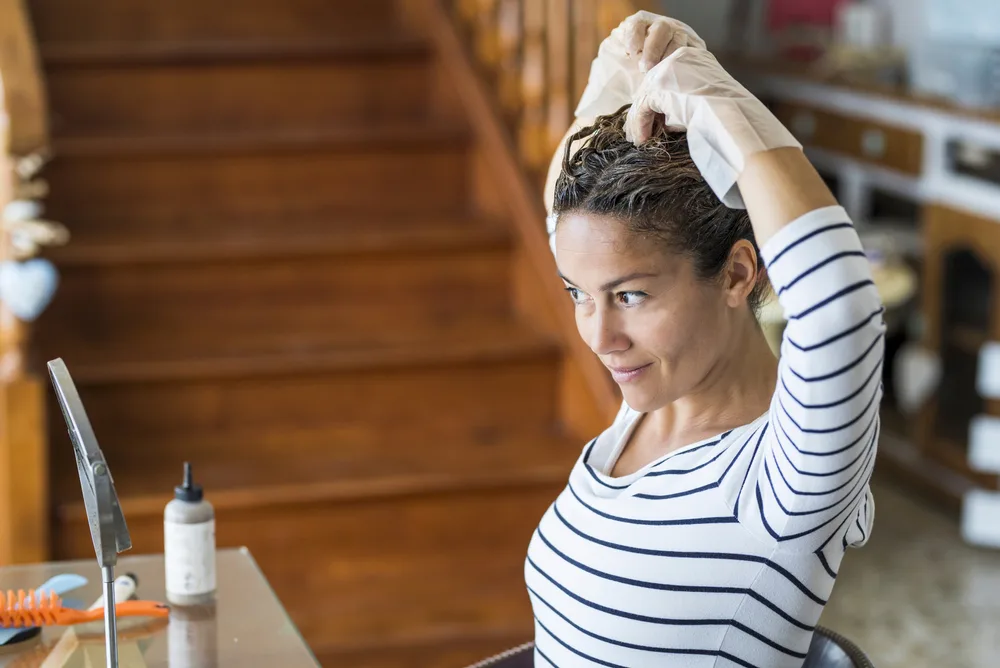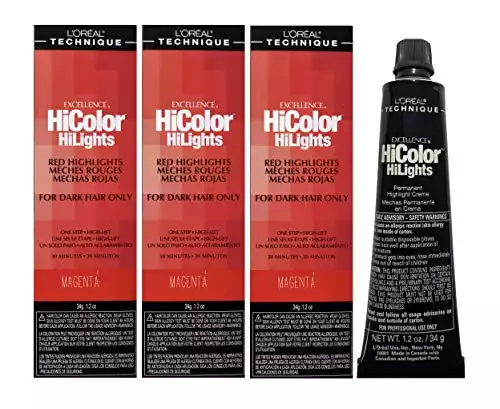Jump to:
Many people choose to use a product like L’Oréal HiColor to color their hair without having the damaging effects of bleach, but the question remains: does L’Oréal HiColor damage your hair? Read on to learn more about how it works and how to avoid damaging your hair.
What Is L’Oréal HiColor?
L’Oréal HiColor is a specially formulated hair color treatment designed to transform dark hair into light, bright colors without using bleach. L’Oréal HiColor works by both lifting existing pigment from the hair and depositing new pigment to create new hair color.
The lifting or lightning aspect of the process is when your hair is most at risk to become damaged. To lift hair color without bleach, you need to use a developer.
A developer is a thick, creamy hair product that resembles the texture and appearance of a hair conditioner. Hydrogen peroxide is an active ingredient in hair developers.
Read Next: What Does Hair Developer Do on Its Own?
Hydrogen Peroxide
Hydrogen peroxide opens up the hair’s cuticles and breaks down the chemical bonds that form melanin, the substance that creates your natural hair color.
Hydrogen peroxide also interacts with the ammonia in hair dye to trigger the oxidation process, which allows a new color to appear on your hair. Hair developers can damage your hair by opening your cuticles too much, causing split ends, breakage, and frizzy hair.
Your skin can also have a bad reaction from overexposure to hydrogen peroxide. Additionally, some people have a negative scalp reaction to hydrogen peroxide, which can cause hair loss.
Developer Volume
Hair developers are categorized by volume, which refers to how much hydrogen peroxide is in the developer. Lower-level developers, such as a 10-volume developer, are fairly gentle on your hair and don’t do much damage to your cuticle.
However, L’Oréal HiColor requires you to use a 30 or 40-volume developer, which contains a high amount of hydrogen peroxide.
A developer with this great a volume is intended for lifting your hair color multiple shades and creating a significant change in hair color. Using that much hydrogen peroxide can leave your hair feeling brittle and dry.
Some of your hair may even break off at the ends, or, in the worst-case scenario, fall off from your scalp. Fortunately, there are steps you can take to safely use 30 or 40-volume developers with L’Oréal HiColor.
Read Next: What Volume Hair Developer Should I Use?
Does L’Oréal HiColor Damage Your Hair?
Ok, now onto the big question — will it damage your hair? The answer is simple: L’Oréal HiColor won’t damage your hair if you take proper preventative steps and follow all the product instructions.
How to Minimize Damage to Your Hair When Using L’Oréal HiColor
If you want to minimize the damage to your hair when using L’Oréal HiColor, you will have to carefully plan your dyeing process to ensure that your hair receives proper care.
Start With Healthy Hair
The most important thing you can do before using L’Oréal HiColor is to start with healthy hair. When considering whether L’Oréal HiColor is right for you, inspect your hair. Check for dryness and split ends.
If your hair is already having issues like split ends, the developer and hair dye in L’Oréal HiColor will only exacerbate the problem. You should also refrain from using L’Oréal HiColor if your hair has already been treated with another chemical or hair dye.
This includes bleach, hair relaxers, or temporary hair dyes. Using L’Oréal HiColor on chemical-treated hair can cause significant damage. The way you care for your hair in the weeks leading up to applying L’Oréal HiColor matters as well.
Don’t use heat styling methods or pull your hair back in tight braids or ponytails during the days before dyeing your hair. Heat and tension can both make your hair more vulnerable to dryness and breakage. Finally, you may want to avoid shampooing your hair for a few days before you use L’Oréal HiColor.
Hair colorists recommend refraining from cleansing your hair before certain treatments, as your scalp’s natural oils can protect and nourish your hair. Instead of cleansing, focus on a pre-hair dyeing routine that prioritizes. moisturizing conditioners.
Follow the Directions
To prevent hair damage, follow all of the L’Oréal HiColor directions exactly. The directions that come with the hair dye will tell you precisely how much dye and developer to use, how to apply it to your hair, and how long to leave it in.
Improperly mixing your hair developer and dye won’t give you your desired results and may harm your hair. Leaving chemicals on your hair too long — especially hydrogen peroxide — will irritate your scalp and can cause serious damage to your hair and skin.
If you have concerns over how your hair will react to L’Oréal HiColor, test the product out on a small section of hair first. This test gives you an accurate idea of how your entire head of hair will look after dyeing it.
Moisturize and Nourish Your Dyed Hair
In addition to moisturizing your hair before dyeing it, you should also pay extra attention to moisturizing and nourishing your hair in the weeks that follow. Hair developers and dyes dehydrate your hair and break down important chemical bonds.
You will need to use quality hair conditioners to help your hair recover. Investing in hair conditioners specifically formulated for color-treated hair can make a notable difference in how your dyed hair looks and feels.
Avoid Heat Damage
Limit the frequency in which you use heat on dyed hair. You don’t have the same natural defense against heat damage as you did before since hair developers and dyes have broken down the protective cuticles surrounding your hair.
Air dry your hair whenever you can and use low-temperature settings when you do use heat styling tools. And, of course, always remember to apply a heat protectant to your hair before doing any heat styling.
Frequently Asked Questions

Simona Pilolla 2/Shutterstock
Here are some frequently asked questions on whether or not L’Oréal HiColor damages your hair.
How long should I leave in L’Oréal HiColor?
L’Oréal instructs you to leave L’Oréal HiColor in your hair for 30 minutes. While the dye sits in your hair, you should stay in a room temperature environment. Once the 30 minutes is complete, rinse your hair thoroughly with warm water.
How much hair developer do you use with HiColor?
According to the L’Oréal HiColor instructions, you should mix one part hair color with one and a half parts hair developer.
Can you use HiColor without a developer?
Technically you can use L’Oréal HiColor without a developer, but you probably won’t get any color results in your hair. You need a hair developer to lift the existing pigment in your hair, or else your hair will be too dark for the new color to be visible.
Can I use a conditioner instead of a developer?
No, you cannot use hair conditioner in place of a hair developer when dyeing your hair. Conditioner moisturizes your hair, but has no effect on the pigment in your hair and thus won’t do anything to make your hair dye more visible.
Does HiColor work on black hair?
Yes, L’Oréal HiColor can dye naturally dark hair, including black hair.
So, Does L’Oréal HiColor Damage Your Hair?
L’Oréal HiColor won’t damage your hair if you take proper preventative steps and follow all the product instructions. No hair color treatment is completely harmless for your hair, but L’Oréal HiColor is a great lower-risk alternative to using bleach. So what are you waiting for — try it out today!

